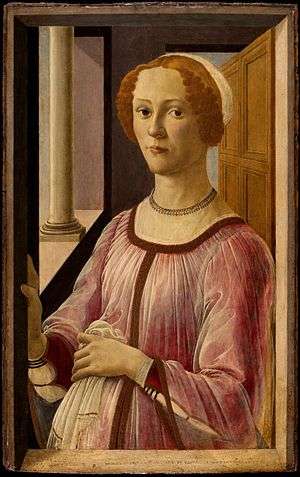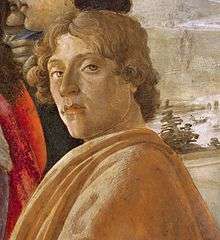Portrait of a Lady Known as Smeralda Brandini
 | |
| Artist | Sandro Botticelli |
|---|---|
| Year | c. 1471, 1470s |
| Medium | Tempera on panel |
| Dimensions | 65.7 cm × 41 cm (25.9 in × 16 in) |
| Location | Victoria and Albert Museum, London |
The Portrait of Smeralda Brandini is a tempera on panel painting by the Italian Renaissance artist Sandro Botticelli of about 1475, in the Victoria and Albert Museum, London (museum no. CAI.100).
Sitter and author
The identification of the sitter is based on the old, but probably not original, inscription on the windowsill at the bottom of the picture Smeralda di M.Bandinelli Moglie di VI... Bandinelli, who has been identified as the grandmother of the sculptor Baccio Bandinelli.[1] It is likely that the inscription was added at a later date, as the sculptor only took that surname in 1530.[2]
On the evidence of the inscription, the portrait may be of Esmeralda (Smeralda) Donati Brandini, the wife of Viviano Brandini, mother of the prominent Florentine goldsmith Michelangelo de Viviano de Brandini of Gaiuole, and grandmother of the sculptor Baccio Bandinelli (the son of Michelangelo and his noble wife Catarina, a daughter of Taddeo Ugolino). From archive documents it is known that in 1469 Smeralda was 30; her husband Viviano 38; their children Michelangelo 12, Giovanbatista 2, and Lucrezia 10.[3]
It has been suggested that the portrait was painted by one of Botticelli's assistants during the 1470s. William Michael Rossetti said: "Leading critics will now have it that the portrait is not the work of Botticelli himself, but of someone for whom they have invented the name 'Amico di Sandro'".[4] The V&A, however, still attributes the painting to Botticelli himself. It was once suspected that the portrait was one of Ignazio Hugford II's forgeries.[5]
The art historian Julia Cartwright (1851–1924) refers to the sitter as the wife of Michele Bandinelli of Gaiuole, and attributes the portrait to an assistant of Botticelli.[6] Although she names Smerelda and says that Michele was a talented goldsmith who had the Medici as clients for many years, is likely that Cartwright has confused Viviano with his son Michelangelo (Michele) because in 1475, the year of the tournament of La Giostra to which she refers, Michele was only 18 years old and his father was much better known.[7]
Composition
Art historians note new features in the composition: "earlier Florentine portraits were in profile. The woman's three-quarter pose, with her hand on the window frame, was Botticelli's own invention". The portrait is thought to be the first example of a three-quarters pose in Florentine portrait painting. "By abandoning the profile pose traditionally used in depictions of Renaissance women, Botticelli brought a new sense of movement into the portrait."[2] The innovation was adopted by later artists.
The painting helped art historians to identify the sheer overdress worn by the Mona Lisa, a "similar" guarnello. The sitter also wears a cotta, a light summer gown. The location is unknown: maybe it is a loggia, or open-air colonnade.
Provenance
By the early 19th century (1805) the portrait was in the collection of comte James de Pourtalès Gorgier (1776–1855) in Paris. A catalogue of public sales printed in France in 1866 records the sale of the picture by the comte de Pourtalès Gorgier for 3,400 francs in 1865.[8] Charles Augustus Howell bought it on behalf of Dante Gabriel Rossetti in 1867 at Christie's; Rossetti boasted that he had it for £20. It was bequeathed to the V&A with the collection of his patron Constantine Alexander Ionides, who had bought it from Rossetti for £315 in the 1880s.[9]
Dante Gabriel Rossetti refers to the painting in his comments on his poem "For Spring, by Sandro Botticelli":[4]
What masque of what old wind-withered New-Year
Honours this Lady?* Flora, wanton-eyed
For birth, and with all flowrets prankt and pied
with his reference: * The same Lady, here surrounded by the masque of Spring, is evidently the subject of a portrait by Botticelli formerly in the Pourtales collection in Paris. This portrait is inscribed "Smeralda Bandinelli".[10] Rossetti's suggestion that the portrait depicted the model Botticelli used for his Spring now seems unlikely.[11]
Notes
- ↑ Vanessa Müller."how Botticellian!"
- 1 2 Victoria and Albert Museum web-site
- ↑ Louis Alexander Waldman. Baccio Bandinelli and art at the Medici court
- 1 2 Rossetti Archive. For “Spring” by Sandro Botticelli (in the Accademia of Florence)
- ↑ Fabulous Faces; Dulwich Gallery Has Scored a Coup with Its New Show of Artists' Self Portraits from the Uffizi's Sublime Collection // The Evening Standard (London, England), May 18, 2007.
- ↑ Esther D. Singleton. Great Portraits, as Seen and Described by Great Writers. P.129
- ↑ Later, in his Lives, Vasari singled out Michele as the best jeweller in Florence (see note 3, chapter 86, book 1). Michele became the first master of Benvenuto Cellini (1516-17) who hated Michele's son Baccio Bandinelli and wrote in his Vita (I, VII) that Michele was simply a collier's son.
- ↑ Catalogue général des ventes publiques de tableaux et estampes depuis 1737 jusqua'à nos jours (1866)
- ↑ James Perrin Warren. Walt Whitman's language experiment
- ↑ Rossetti Archive Textual Transcription
- ↑ Painting (CAI.100) at the V&A
Articles
- Gail S. Weinberg. D.G. Rossetti's ownership of Botticelli's 'Smeralda Brandini' in The Burlington Magazine, January 2004
